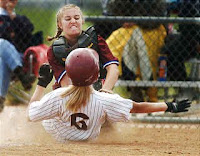
I consider myself to be pretty athletic. I am decent at most sports, although my favorite, by far, is softball. For thirteen years growing up I played competitive fast-pitch softball. That’s lots and lots of hours spent practicing to fine tune specific skills. When I was a freshman in college, a friend of mine tried to teach me how to play tennis. I was terrible! It turns out that swinging a tennis racket and swinging a softball bat are different enough motions that if you try to swing a racket the same as you swing a bat you will fail miserably. And I did. But I was so used to swinging a bat that I could not adjust, and I gave up on tennis.
tennis racket and swinging a softball bat are different enough motions that if you try to swing a racket the same as you swing a bat you will fail miserably. And I did. But I was so used to swinging a bat that I could not adjust, and I gave up on tennis.
 tennis racket and swinging a softball bat are different enough motions that if you try to swing a racket the same as you swing a bat you will fail miserably. And I did. But I was so used to swinging a bat that I could not adjust, and I gave up on tennis.
tennis racket and swinging a softball bat are different enough motions that if you try to swing a racket the same as you swing a bat you will fail miserably. And I did. But I was so used to swinging a bat that I could not adjust, and I gave up on tennis. Since making the decision to homeschool, I’ve realized that I’m up against a similar struggle. This time, however, I am bound and determined to make the adjustment. I am an alumnus of the public school system. Although I don’t feel like I had an awful experience in public school, I think that homeschool has more to offer. But trying to imagine myself homeschooling was like trying to play tennis. At first, when I thought about it, I pictured my kids sitting in little desks in our living room while I stood in front of them and lectured all day. Thankfully, after a little research, I discovered that homeschoolers swing the racket a little differently. The trick is to learn how, without letting my public school mind set get in the way.
Recently I attended a homeschooling conference. The instructor talked a little bit about paradigms. He defined a paradigm as, “A set of assumptions, concepts, values, and practices that constitutes a way of viewing reality for the community that shares them.” The phrase, “a way of viewing reality” really stands out to me as a reminder that there are many different realities depending on your perspective or your experience. Sometimes when I am trying to learn new things I dig myself a hole because I only try to do it one way—the way I know. By shifting my paradigm a little, I’m learning that an education doesn’t have to be the same 8:00-3:00, lectures, quizzes, and one-subject-at-a-time routine I grew up with.

When I first started researching about homeschooling, my favorite thing to do was to read about the creative ways people came up with to encourage their kids to learn. An experience that’s coming to mind is a woman whose son was interested in squid. She ran with it. They read 20,000 Leagues Under the Sea, they visited an aquarium, they ate squid at a restaurant, they dissected a squid, etc. Tons of learning going on there, and her son was all over it because he was interested. Stories like this fascinate me, because they are so foreign to the experiences I had in school. I want to learn how to create an environment like that for my kids. But in order to do that I have to teach my mind to put down the bat and pick up the racket, so to speak. And that’s going to take some effort.
And who knows, if this homeschooling thing works out, maybe I’ll give tennis another shot. :)
Recently I attended a homeschooling conference. The instructor talked a little bit about paradigms. He defined a paradigm as, “A set of assumptions, concepts, values, and practices that constitutes a way of viewing reality for the community that shares them.” The phrase, “a way of viewing reality” really stands out to me as a reminder that there are many different realities depending on your perspective or your experience. Sometimes when I am trying to learn new things I dig myself a hole because I only try to do it one way—the way I know. By shifting my paradigm a little, I’m learning that an education doesn’t have to be the same 8:00-3:00, lectures, quizzes, and one-subject-at-a-time routine I grew up with.

When I first started researching about homeschooling, my favorite thing to do was to read about the creative ways people came up with to encourage their kids to learn. An experience that’s coming to mind is a woman whose son was interested in squid. She ran with it. They read 20,000 Leagues Under the Sea, they visited an aquarium, they ate squid at a restaurant, they dissected a squid, etc. Tons of learning going on there, and her son was all over it because he was interested. Stories like this fascinate me, because they are so foreign to the experiences I had in school. I want to learn how to create an environment like that for my kids. But in order to do that I have to teach my mind to put down the bat and pick up the racket, so to speak. And that’s going to take some effort.
And who knows, if this homeschooling thing works out, maybe I’ll give tennis another shot. :)












